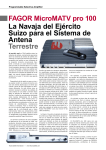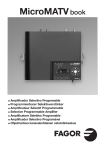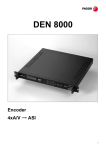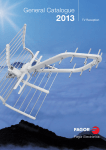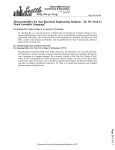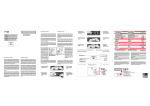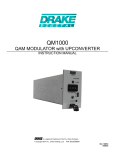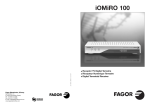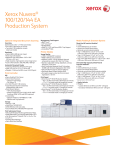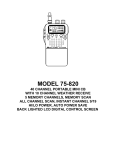Download The Microma-MATV Aerial System Test Report (400kb pdf)
Transcript
TEST REPORT Programmable Selective Amplifier FAGOR MicroMATV pro 100 Swiss Army Knife for the Terrestrial Antenna System When writing about antenna systems here in TELE-satelite, we usually mean the satellite antenna systems. However, most of us who use the satellite receivers do not resign from the conventional terrestrial reception. After all, quite often an interesting channel is transmitted for free in your region via the terrestrial transmitter. This channel may be not available through satellite (for example local news channel) or be a part of a Pay-TV satellite package. New digital channels show up in the terrestrial TV what keeps it attractive. Depending on the region you live, you can receive the terrestrial channels with either a single dipole/yagi antenna or you have to install a number of them pointing in different directions. In the latter case, it is always necessary to combine the signals from a few antennae into one signal and send it down to the TV-set. In the family house, such signal is usually distributed among many rooms. In the block of apartments – among many flats. Combining the signal from different antennae was usually done with a mixture of amplifiers, multiplexers and filters (or traps). For a regular mortal, it was a kind of black magic what kind of equipment should he or she use and how to interconnect all components. This kind of problem does not exist when you have a selective programmable amplifier from Spanish company Fagor Electronica. The first products from that company appeared on the market already in 1992. The products offered now belong to the third generation. Fagor Electronica designed and produced a family of products called MicroMATV pro, models: 100, 100C, 200C and 300C. They differ in number of inputs and Automatic Gain Control function. To put it simply, a selective programmable amplifier enables us to connect a several antennae to one TV-set or to one distribution cable network. We took a closer look at the MicroMATV pro 100 model. You can connect up to six different antennae for various bands. You have the following inputs: FM (87.5-108 MHz0, BI (47-68 MHz), BIII/DAB (174-230 MHz) and 3 UHF inputs (470-862 MHz). Unfortunately the model we tested had no SAT IF input (9502150 MHz). This input is available in models 200C and 300C. However, it had an auxiliary input AUX (47-68, 130-862 MHz). Using this input and the additional device of Fagor Electronica called DISAT-4, you can connect a satellite dish to the system. Alternatively, the AUX input may be used for some other TV or radio signal (for example from another MicroMATV amplifier output or from an existing cable TV network). Programmable Selective Amplifier TEST REPORT Figure 1 shows the exemplary antenna system that Fagor Electronica provide in their user manual. Not only can you connect a number of antennae to the amplifier but also you have the possibility to adjust its amplification for different inputs. And that’s not all. In the UHF bands, you can set a number of filters so that to pass only a portion of the UHF frequency spectrum: 470-862 MHz. In this way, you filter out the part of band in which the TV channels that you want to receive are transmitted. For example: you may take channels settings and a power cord for 230Vac supply. The unit itself is rather big and heavy and it is designed to be wall mounted in the indoors. It makes an impression of a very solid piece of equipment. Its workmanship leaves nothing to be desired. The user manual that we got along with the unit was prepared in Spanish, French and English. Apart from the specifications, it includes the programming guide. At first we were somewhat afraid that it may be not that easy to enter all the necessary settings, but the reality was quite the Fig. 1. Exemplary antenna system We started with FM band. As you can see in figure 2, the filter amplitude response is practically perfect. No passband ripple, and very steep rolloff of 25dB/8MHz. Filter covers exactly 87.5-108 MHz band. [Fig. 2.] The gain can be adjusted in 25 steps. According to the specification, the adjustment range should be 25 dB. We measured that actually the range is somewhat bigger: 28 dB. One step is roughly 1 dB. The difference between specification and actual adjustment range was even bigger in BI band (47-68 MHz). Instead of 25 dB adjustment range, the actual range was 35 dB. So, we got something between 1.5 and 1.7 dB per one step. While in practice, greater range and coarser resolution of the gain adjustment should not pose any problem, it is still a certain deviation from the published specification. The frequency response for this input was as perfect as for the FM input. Rolloff was about 20dB/8MHz. See figure 3. [Fig. 3.] BIII input (174-230 MHz) was better with respect to gain setting. For settings between 0 through 20 the actual changes were almost exactly 1 dB per step. For settings between 20 and 25 it was about 1.5 dB per step. Low ripple in the passband – see figure 4 but the rolloff of 10dB/8MHz was not equally good as for the previous inputs. [Fig.4.] 20-25, 36-37 and 55-60 from the first UHF antenna, channels 40-42 and 63-65 from the second UHF antenna and channels 29-32 from the third UHF antenna. You may set up to 10 different filters in UHF band. The filter’s pass-through bandwidth can be individually set from a single channel (8 MHz) to six channel (48 MHz). opposite. The control unit with 2 line liquid crystal display and five buttons could not be simpler to operate! It takes rather seconds than minutes to understand its logic. MicroMATV pro 100 comes with an external control unit used to enter all necessary For our tests, we used the NG-281 noise generator and the Prolink-4C Premium spectrum analyzer of PROMAX. Additionally, we checked the operation of the amplifier with the real TV and radio signals of different frequencies. Fig. 2. FM input frequency response Fig. 3. BI input frequency response Before dealing with the UHF bands, we quickly checked the auxiliary input (47-68, 130-862 MHz). The flatness of its frequency characteristics was a nice surprise – see figure 5. You should take into account that our noise generator had ca. 5 dB decrease in amplitude at maximum frequency. So the amplifier itself introduce maybe 1 or 2 dB difference in amplitude response over the entire band! [Fig. 5.] When we moved to the most interesting inputs – UHF inputs, the first observation was Fig.4. BIII/DAB frequency response TEST REPORT Programmable Selective Amplifier that the rolloff of the filter is slightly worse compared to the previous fixed band inputs. Although we got quite good 17dB/8MHz for the lower slope but only 9dB/8MHz for the upper slope of the filter. When the filter was set to one or two channel bandwidth, its frequency response looked quite good, but for the wider settings we observed a dip between 2 peaks in the passband. Figure 6 shows a filter set for 1 channel and figure 7 shows filter set for 6 channels. [Fig. 6.] [Fig. 7.] Fig. 5. Auxiliary input frequency response Still more passband ripple resulted when we tried to achieve more than 6-channel wide bandwidth by setting 2 adjoining filters on one UHF input. We set the first filter for channels 21-26 (474-514 MHz) and the second filter for channels 27-32 (522-562 MHz). In such configuration, one could expect a frequency response more or less flat for channels 2132 (474-562 MHz). As you can see in figure 8, the frequency response was not perfectly flat. It had peaks and dips. Of course, this will result in lower and higher amplification of different TV channels. Fortunately, the difference was not great and it should not pose any problem for the TV-set to cope with such differences. [Fig. 8.] The gain setting for the UHF bands turned out to be very linear. Every 5 step setting change resulted in almost exactly 5 dB change of the amplifier output. Apart from the frequency response and gain setting, we took a several measurements of signal to noise. All of them showed almost no degradation of S/N ratio between amplifier output and input. MicroMATV pro 100 is really a low + noise amplifier! Also, all the practical tests with live TV signals showed absolutely no distortion or noise in the output of the device. The MicroMATV pro programmable selective amplifiers have other practical features like Automatic Equalization System or Automatic Gain Control. AES when activated, measures the signal at all inputs and automatically sets the optimum gain setting for every band. This is extremely convenient! Without this feature, the installer should either use something like spectrum analyzer to check the output level for every channel or group of channels or do it by trial and error. AGC helps keeping the optimal output level when incoming signal changes in power, for example due to weather conditions. The amplifiers can automatically recognize the digital channels and keep their level 15 dB below the analog channel level. Thanks to this, DVB-T receivers or digital/analog TV-sets work properly. We can say that Fagor’s selective amplifiers are really ready for today’s mixed analog/digital terrestrial transmissions. Expert conclusion Very versatile, replaces big number of classical devices like amplifiers, filters or multiplexers. Easy programming. AES function makes the necessary adjustments very simple. Low noise. Flat frequency response of the AUX amplifier. - Fig. 6. UHF filter set to one channel bandwidth Different sensitivity of gain setting (dB per step) on various bands. The rolloff of the upper slope of UHF filters could be steeper. Peter Miller TELE-satellite Test Center Poland TECHNICAL DATA Fig. 7. UHF filter set to six channel bandwidth Fig. 8. Interaction between two adjoining 6-channel wide filters Manufacturer Fagor Electronica, S.Coop., San Andres, Mondragon, Spain www.fagorelectronica.es E-mail [email protected] Phone +34 43 712526 Fax +34 43 712893 Model MicroMATV pro 100 Description Programmable Selective Amplifier Inputs FM, BI, BIII/DAB, AUX, 3xUHF Number of programmable amplifiers/filters in UHF band 10 Programmable filter bandwidth 8 - 48 MHz (1-6 channels) Maximum gain 23-53 dB (depending on band) Input adjustment 23-25 dB (depending on band) Output adjustment 20-25 dB (depending on band) Noise factor 6-8 dB (depending on band) Output level 116 dBµV (DIM –35dBc) for FM 121 dBµV (DIM –60dBc) for other bands Power supply 230 Vac ±15% Ambient temperature 0-50ºC



